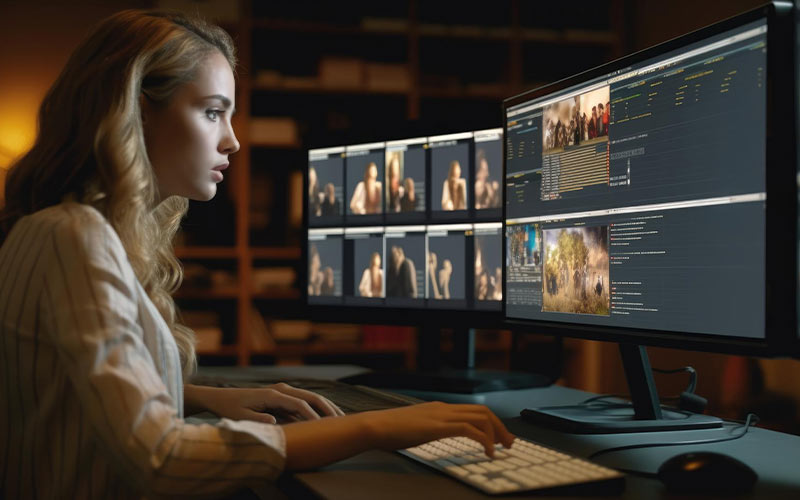Table of Contents
# What Is VFX Training and What It Covers?
# What Software and Tools Are Commonly Used in VFX, And Will the Training Cover Them?
# Are You Looking for The Best VFX Institute in Kolkata?
# Conclusion
Imagine a world where creativity and technology coexist, where people possess both the artistic talent and the technical know-how to create beautiful, lifelike visual wonders across a diverse range of mediums. The captivating world of VFX training is the laboratory where aspiring artists and dreamers refine their talents to create a mesmerising symphony of visual upgrades that go beyond the realm of possible.
VFX training immerses students in the art of creating captivating visual elements that transcend conventional boundaries, whether it be in the grand cinematic canvas of films, the compelling narrative realms of television shows, the immersive landscapes of video games, or the impactful messages of advertisements.
In this blog, we will cover a comprehensive guide of VFX training and will also see what software and tools are commonly used in VFX, and will the training cover them?
What Is VFX Training and What It Covers?
A focused educational experience called “visual effects training,” also referred to as “VFX training,” gives students the skills they need to produce imaginative and lifelike visual enhancements for use in movies, television programmes, video games, advertising, and other types of media.
This specialized training covers a wide range of fundamental techniques, including computer-generated imagery (CGI) production, the skill of digital compositing, precise motion tracking, the intricate art of matte painting, and a variety of other abilities meant to improve or even create visual elements that pose challenges or are impossible to achieve through conventional filming techniques.
Through this programme, individuals get the technical know-how required for efficient VFX production as well as the artistic abilities to aesthetically enhance narratives through the use of visual elements.
What Software and Tools Are Commonly Used in VFX, And Will the Training Cover Them?
The breadth and depth of training programmes might vary depending on the emphasis and usage of the programme. A number of applications and technologies are frequently used in the field of VFX. In VFX, the following are some of the fundamental programmes and apparatus:
Adobe After Effects: Motion graphics and compositing professionals frequently use Adobe After Effects. It is necessary for building visual effects by layering different elements.
Autodesk Maya: Autodesk Maya is a flexible 3D animation and modelling programme that can be used to build intricate 3D models, characters, and scenes.
Blackmagic Fusion: Productions of films and television shows frequently employ the node-based compositing programme Blackmagic Fusion.
Nuke: The VFX industry holds Nuke in high respect for its sophisticated node-based compositing software and cutting-edge features.
Cinema 4D: Frequently used for 3D motion graphics, visual effects, and animation, Cinema 4D is especially well-liked in the advertising sector.
Houdini: Houdini is a popular tool for building intricate simulations, particle systems, and visual effects. It is renowned for its procedural approach.
ZBrush: Essential for digital sculpting, especially when making highly detailed 3D models, is ZBrush.
Adobe Photoshop: Useful for texturing, matte painting, and image manipulation.
Mocha: Used for object removal and tracking motion.
3ds Max: Popular for 3D rendering, animation, and modelling is 3ds Max.
Blender: Blender is a free and open-source 3D design toolkit that may be used for modelling, animation, rendering, and other tasks.
Particle Systems: A collection of plugins and software tools for producing lifelike particle effects, such as fire and smoke.
Now, will the training cover them?

The precise programme you select will determine how much of this software and equipment is covered in VFX training. While shorter or more focused courses could concentrate on a certain tool or technique, more comprehensive programmes are likely to include many software programmes.
Reviewing the curriculum of the training programme you’re thinking about is essential to make sure it corresponds with the software and skills you wish to learn.
A solid foundation in the fundamental ideas of VFX is crucial for remaining versatile throughout your career because VFX practitioners frequently adapt to new software and tools as the business changes. If you want to get enrolled in VFX training then choose VFX training institute in Kolkata as in Kolkata there are many reputable and renowned VFX training institutes.
Are You Looking for The Best VFX Institute in Kolkata?
There is absolutely no need to hustle with the best VFX institute in Kolkata as George Animatrix is the best VFX institute in Kolkata. Without a second thought you should enroll in their VFX training program. Their VFX training is delivered by most experienced faculty who aim to provide comprehensive information.
Conclusion
VFX training offers a doorway to an innovative and creative world where people may learn to create stunning visual effects that capture viewers in a variety of media. Choose a programme that aligns with your aims and desires as you begin your VFX adventure to pave the way for a fulfilling career in the exciting field of visual effects. If you’re seeking for trustworthy VFX training, think about checking into the possibilities offered by recognised institutions like those in Kolkata, where you’ll get the knowledge and direction required to succeed in this fast-paced industry.



